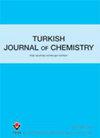TiO2与共掺杂CdS量子点光电极的结构设计
IF 1.4
4区 化学
Q3 CHEMISTRY, MULTIDISCIPLINARY
引用次数: 0
摘要
光电化学制氢是解决各国零碳目标的关键,因为太阳能可再生能源和氢水的燃烧产物。本文利用简单离子层吸附反应(SILAR)方法,利用CdS和共掺杂CdS量子点(QDs)进行了n型纳米玫瑰棒TiO2 (RT)表面的结构设计。此外,研究了共掺杂CdS QDs SILAR循环沉积的光催化行为,包括5、8、10和12个循环。利用FESEM、Raman XRD、Uv-Vis光谱仪和振动模式分别评价了光电极的表面结构、晶体结构和太阳光吸收。FESEM图像和XRD图谱显示CdS QDS和共掺杂CdS QDS连续沉积在RT边界上,共掺杂CdS QDS的SILAR循环周期增加导致RT表面进一步覆盖。紫外-可见谱仪表明,通过施加更多的SILAR循环,共掺杂CdS量子点沉积可以将太阳光吸收转移到可见光区。电化学参数显示,10个SILAR循环共掺杂CdS量子点沉积(5093 Ω cm2和617 Ω cm2)显著降低了RT电极的总极化电阻(Rp)。线性扫描伏安法(LSV)和光催化性能测试表明,共掺杂CdS量子点在RT上极大地增强了太阳辐照下的光响应,10个SILAR周期共掺杂CdS量子点使空白RT电极的光电流密度提高了约4倍。本文章由计算机程序翻译,如有差异,请以英文原文为准。
Architecture design of TiO2 with Co-doped CdS quantum dots photoelectrode for water splitting
Photoelectrochemical hydrogen production is a critical key to solving the carbon-zero goal of countries due to renewable sources of solar light and combustion products of hydrogen-only water. Here, an architecture design for an n-type nano rosettes-rod TiO2 (RT) surface using CdS and Co-doped CdS quantum dots (QDs) is carried out utilizing the SILAR (simple ionic layer adsorption and reaction) method. Furthermore, the photocatalytic behaviour of Co-doped CdS QDs SILAR cycles deposition is investigated in various cycles, including 5, 8, 10, and 12. The FESEM, Raman XRD, Uv-Vis spectrometer, and vibration modes are used to evaluate the photoelectrode surface structure, crystal structure, and solar light absorption, respectively. FESEM images and XRD pattern revealed successive CdS QDS and Co-doped CdS QDs deposition on the RT boundary and rising SILAR cycles of Co-doped CdS QDs lead to further coverage of RT surface. UV-vis spectrometer indicated shifting solar light absorption to the visible region by applying more SILAR cycles of Co-doped CdS QDs deposition. The electrochemical parameters obtained from EIS showed total polarization resistance (Rp ) of the RT electrode dramatically decreased with 10 SILAR cycle Co-doped CdS QDs deposition (5093 Ω cm2 and 617 Ω cm2 ). Linear sweep voltammetry (LSV) and chronoamperometric photocatalytic performance measurements indicated Co-doped CdS QDs on RT extremely enhanced photoresponse under solar irradiation and 10 SILAR cycle Co-doped CdS QDs improved photocurrent density about fourfold according to blank RT electrode.
求助全文
通过发布文献求助,成功后即可免费获取论文全文。
去求助
来源期刊

Turkish Journal of Chemistry
化学-工程:化工
CiteScore
2.40
自引率
7.10%
发文量
87
审稿时长
3 months
期刊介绍:
The Turkish Journal of Chemistry is a bimonthly multidisciplinary journal published by the Scientific and Technological Research Council of Turkey (TÜBİTAK).
The journal is dedicated to dissemination of knowledge in all disciplines of chemistry (organic, inorganic, physical, polymeric, technical, theoretical and analytical chemistry) as well as research at the interface with other sciences especially in chemical engineering where molecular aspects are key to the findings.
The journal accepts English-language original manuscripts and contribution is open to researchers of all nationalities.
The journal publishes refereed original papers, reviews, letters to editor and issues devoted to special fields.
All manuscripts are peer-reviewed and electronic processing ensures accurate reproduction of text and data, plus publication times as short as possible.
 求助内容:
求助内容: 应助结果提醒方式:
应助结果提醒方式:


